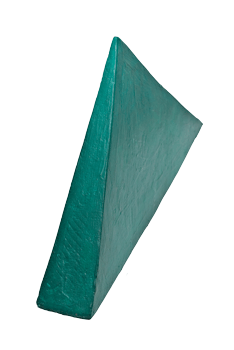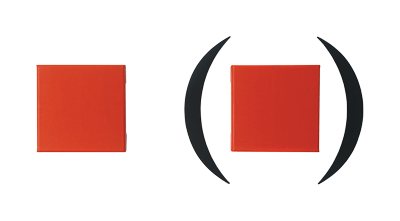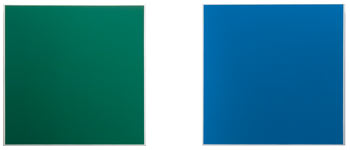The publication of the only issue of arturo magazinein 1944 marked the beginnings of the first movement of abstract art in Argentina. It is a form of art that invents and opposes the symbols and automatism defended by coexistent surrealists. Painting was moving away from representation, becoming autonomous, concrete, and at the same time not reproducing or copying objects. An aesthetic of mathematical rational nature seemed to be more suitable for artists striving to validate the modern project. In the context of the postwar reconstruction, concretism followers adhered to socialist revolutionary humanism. Ever since then, an extensive geometric tradition was established in Argentinean art reaching different generations of artists at present.
In July of 2010, the Recoleta Cultural Center of Buenos Aires unveiled Monocromos, an exhibition by Eduardo Costa, Horacio Zabala and Marcelo Boullosa, three contemporary artists who renewed reflections about the cero degree in painting. Geometrics and conceptualism came together in the experimentation with monochromes that, being born from the heart of modern art poetics, continue to grasp different meanings. Monochromes speak for themselves of the history of painting from them matter to the meanings. About its object-related characteristic and self-referential meaning, Frank Stella used to say: “you see what you see.” But every tradition carries its own logic of rupture, so the monochrome took on a new meaning in contemporary art as it tried to slip in through gaps of international and local tradition, developing a criticism of concepts of art and perception established by the avant-garde. Current monochromes can refer to themes and narrations that would have been branded spurious by the modernist orthodoxy.
 Eduardo Costa’s volumetric monochromes are a tribute to matter turned into form. Totally made with acrylic paint carefully applied one coat on top on the other provide painting with a feature it had historically lacked: three-dimension. In 1994, Eduardo Costa started to create this type of works. Following the traces of the History of Art, Costa took his naturalist volumetric paintings to geometry (spheres, cylinders, parallelepipeds) and immediately after to abstraction, with his current “expanded monochromes,” fragments of landscapes. Costa’s work is effectively assembled to give continuity to, and sometimes break with, different international and local pictorial traditions. In the same way that geometric monochromes are formally in tune with the frequency of concrete art and later of minimalism because of its expression and meaning reduction, they are also the “forms freed from their frame” Argentinean master of Perceptismo Raul Lozza fought for. Concretists from River Plate were the ones who used with a very spirited program the shaped canvas that was later developed by American minimalism. This way, they proposed a painting whose forms in the canvas where the ones to determine the shape of the frame: another way to move away from representation, by abolishing the window format historically represented by the frame. Lozza, in a step further forward, removed the forms of the representation plane from the canvas to place them directly on a wall. Concrete forms representing anything else but themselves, on concrete surfaces, the space, the environment.
Eduardo Costa’s volumetric monochromes are a tribute to matter turned into form. Totally made with acrylic paint carefully applied one coat on top on the other provide painting with a feature it had historically lacked: three-dimension. In 1994, Eduardo Costa started to create this type of works. Following the traces of the History of Art, Costa took his naturalist volumetric paintings to geometry (spheres, cylinders, parallelepipeds) and immediately after to abstraction, with his current “expanded monochromes,” fragments of landscapes. Costa’s work is effectively assembled to give continuity to, and sometimes break with, different international and local pictorial traditions. In the same way that geometric monochromes are formally in tune with the frequency of concrete art and later of minimalism because of its expression and meaning reduction, they are also the “forms freed from their frame” Argentinean master of Perceptismo Raul Lozza fought for. Concretists from River Plate were the ones who used with a very spirited program the shaped canvas that was later developed by American minimalism. This way, they proposed a painting whose forms in the canvas where the ones to determine the shape of the frame: another way to move away from representation, by abolishing the window format historically represented by the frame. Lozza, in a step further forward, removed the forms of the representation plane from the canvas to place them directly on a wall. Concrete forms representing anything else but themselves, on concrete surfaces, the space, the environment.
Eduardo Costa once said: “monochromes are set to incarnate par excellence the ideas of conceptual painting because they reduce colors and the variability of painting to the minimum which makes it the ideal carrier of other contents new to the exuberant tradition of bi-dimensional painting, in which color offers not only the pleasure of contemplation but its capacity to enrich the narrative, highlight the climate, move away some objects and bring others closer, loading certain aspects of the painting with symbolisms and other cultural meanings that endow color with part of its richness.”
At present, Horacio Zabala projects and sets up syntaxes of monochromes that constitute visual-linguistic hypotheses. Sentences of minimal meaning suggesting though a connotative sense, a cadence, an intonation as if it were a piece of music which only those who know how to read it have access to; a metaphor of implicit codes for the comprehension of art.
 “Serie de las hipótesis is an ongoing research about relationions between monochromes (painting without image or composition) and signs (grammatical or mathematical). Although all of them are visible presences, my interest focuses not only on what can be seen but also on what people think of what they see. In general, I’m rather interested in the relations between things than in things as such,” Zabala said.
“Serie de las hipótesis is an ongoing research about relationions between monochromes (painting without image or composition) and signs (grammatical or mathematical). Although all of them are visible presences, my interest focuses not only on what can be seen but also on what people think of what they see. In general, I’m rather interested in the relations between things than in things as such,” Zabala said.
With an architect background, since his years in the Group of 13, Zabala has presented his “drafts” as “the premeditation of a problem, the condensation of an experiment, the result of a suspicion.” According to him, the sketch or outline, both common terms in art, are too close to gesture and improvisation. Drafts, on the contrary, highlight correspondences, links and analogies between monochromes and signs. They don’t give the answer to a riddle but sets up a “rational” argument, at least in its forms, of the “premeditations and suspicions” that motivated them.
 Coming from an younger generation, Marcelo Boullosa entered the scene by the end of the 1980s. Always inside the boundaries of geometry, at the beginning of the 1990s he took on an image that overwhelmed all the registers of the surrounding reality: bar codes. Boullosa used codes as geometric figures per se, but also he pretended to use them to code what couldn’t be coded, the specificity of each of his monochromes. Nowadays, his paintings are loaded with a re-reading of kinetic-optical art. This was a trend to which Argentinean art made important contributions with international figures like Julio Le Parc, Gregorio Vardanega and Martha Boto, among others.
Coming from an younger generation, Marcelo Boullosa entered the scene by the end of the 1980s. Always inside the boundaries of geometry, at the beginning of the 1990s he took on an image that overwhelmed all the registers of the surrounding reality: bar codes. Boullosa used codes as geometric figures per se, but also he pretended to use them to code what couldn’t be coded, the specificity of each of his monochromes. Nowadays, his paintings are loaded with a re-reading of kinetic-optical art. This was a trend to which Argentinean art made important contributions with international figures like Julio Le Parc, Gregorio Vardanega and Martha Boto, among others.
Looked at from different angles, viewers can see subtle sparkles on Boullosa’s paintings. Enclosed in a white painted frame, his monochromes persistently remind us that painting is a frame, a window representing a fraction of the world. A world that is currently and increasingly that of a computer screen.
“In each monochrome I state a slight tone and light variation,” Boullosa said. Being identical in terms of format (square) the thickness of stretchers varies producing different light and shade effects when seen on the virtual grid made up by the wall. The grid’s geometry organizes them; it balances the disorder that results from the different heights and arbitrariness of the composition. I’ve been always interested in providing my paintings with a geometrical rigor that they don’t actually have. Order vanishes away as soon as the eye starts to look for balance, mathematic relations or composition rules. I seek for subtle, slight deviations of what constitutes the norm.”
The reunion of the three artists made it possible to reaffirm the validity of geometry and how it has been nourished by a conceptual approach. Boullosa, Costa and Zabala, each of them on their own way, make their contributions to the prolific tradition of Argentinean abstract art.
Buenos Aires, January 2011
MARCELO BOULLOSA (Buenos Aires, 1956): Self-taught painter and draftsman, his work centers on the crossing between geometry and contemporary social processes. While studying in Washington, DC, he wrote an artist book entitled Save and Safe, critical view of obsessions of the American society.
EDUARDO COSTA (Buenos Aires, 1940): With literature and plastic arts educational background, since the 1960s Costa has been developing a cross game between genres and languages, information exchange and translation. In 1966, he created in Buenos Aires together with Roberto Jacoby and Raul Escari the “media art” genre, which became the forerunner of Latin American conceptualism. He was part of New York’s avant-garde along with Scott Burton, Vito Acconci, Hannah Weiner and John Perreault, among others. He has been living in Buenos Aires since 2002.
HORACIO ZABALA (Buenos Aires, 1943): In 1971 he joined the Group of Thirteen of the Art and Communications Center (CAyC), an interdisciplinary group labeled by the international critic as performers of “ideological conceptualism.” Along with Edgardo Vigo he put on the first mail art exhibition in Argentina (1975). Based in Europe from 1976 to 1998, he worked in different projects including severalartist books in some cases as author and others as editor. In addition to his artistic career, he writes about theory of art.
Related Publications

How Harumi Yamaguchi invented the modern woman in Japan
March 16, 2022












